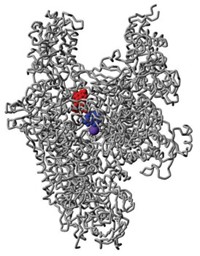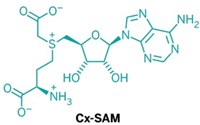Advertisement
Grab your lab coat. Let's get started
Welcome!
Welcome!
Create an account below to get 6 C&EN articles per month, receive newsletters and more - all free.
It seems this is your first time logging in online. Please enter the following information to continue.
As an ACS member you automatically get access to this site. All we need is few more details to create your reading experience.
Not you? Sign in with a different account.
Not you? Sign in with a different account.
ERROR 1
ERROR 1
ERROR 2
ERROR 2
ERROR 2
ERROR 2
ERROR 2
Password and Confirm password must match.
If you have an ACS member number, please enter it here so we can link this account to your membership. (optional)
ERROR 2
ACS values your privacy. By submitting your information, you are gaining access to C&EN and subscribing to our weekly newsletter. We use the information you provide to make your reading experience better, and we will never sell your data to third party members.
Medicinal Chemistry
Human enzyme makes antiviral small molecule
Naturally occurring compound inhibits replication of Zika virus in living cells
by Cici Zhang
June 30, 2018
| A version of this story appeared in
Volume 96, Issue 27

The quest to design new antiviral drugs may have missed an important source: the human body. A team of researchers has discovered that humans express an enzyme that produces a small molecule that inhibits the replication of several viruses, including Zika virus. The molecule could provide a scaffold for new drugs against infectious diseases, the researchers say (Nature 2018, DOI: 10.1038/s41586-018-0238-4).
When fish, birds, and mammals get infected by a virus, one of the genes that turns on to help fight off the invader is Viperin. But scientists didn’t know the source of the gene’s antiviral activity. Although they were aware that the gene encodes an enzyme, little was known about the reactions it catalyzed.
Tyler Grove and Steven Almo at Albert Einstein College of Medicine decided to collaborate with Jamie Arnold and Craig Cameron at Pennsylvania State University to investigate the enzyme’s activity. The enzyme uses S-adenosyl methionine (SAM) to catalyze electron transfers and make radical species. The team found that one reaction it catalyzes is the dehydration of cytidine triphosphate (CTP).
The resulting small molecule, 3′-deoxy-3′,4′-didehydro-CTP (ddhCTP), looks like existing antiviral drugs that disrupt the replication of some viruses’ RNA genomes. In experiments in test tubes, the researchers determined that ddhCTP inhibits the RNA polymerases of Zika virus, West Nile virus, dengue virus, and hepatitis C. It also blocked replication of the Zika virus in monkey cells.
RNA polymerases are responsible for synthesizing RNA for both viruses and other organisms, including humans. ddhCTP looks like a molecule a viral polymerase would use to add to a growing RNA chain, but once it’s added it blocks further synthesis, terminating the RNA chain and resulting in an incomplete viral genome. The researchers are now trying to figure out why ddhCTP doesn’t interfere with humans’ or other organisms’ polymerases.
Peter Cresswell of Yale University, who studies the Viperin gene, says the work is “amazing.” But it doesn’t explain all of the antiviral effects of Viperin, he adds, such as how it disrupts viral DNA replication.
Although drugmakers have designed inhibitors of viral polymerases, biologists weren’t previously aware of organisms producing such antiviral small molecules, says Priscilla Yang, a virologist at Harvard University. The study will stimulate the field to consider the function of naturally produced small molecules, she says.
The team has filed a U.S. provisional patent application and wants to partner with a pharmaceutical company to develop a version of ddhCTP that could get into cells more easily. The researchers are also studying why the viperin enzyme uses CTP to make the antiviral molecule. There might be more clues that could help design even better antiviral compounds, Einstein’s Almo says.




Join the conversation
Contact the reporter
Submit a Letter to the Editor for publication
Engage with us on Twitter